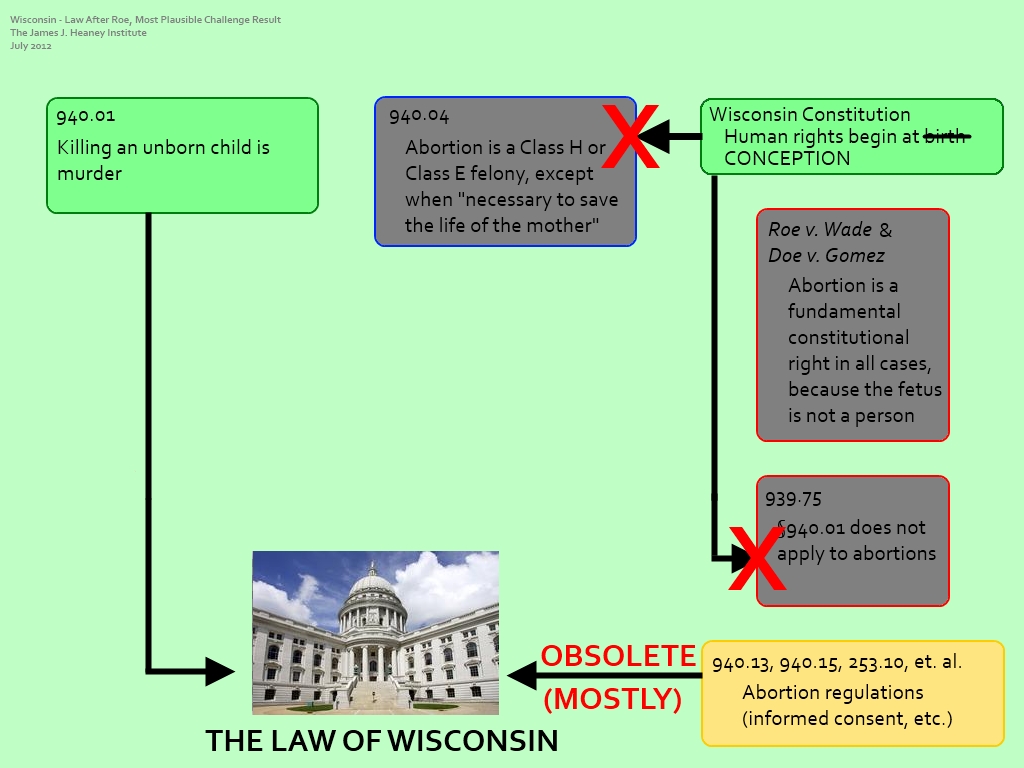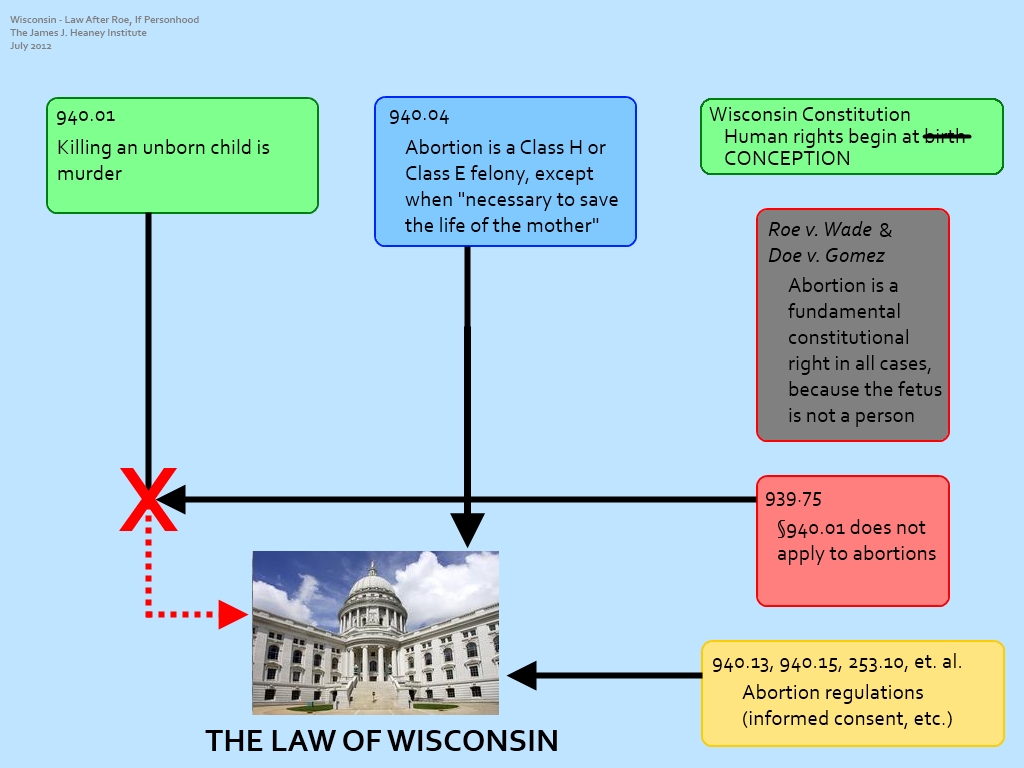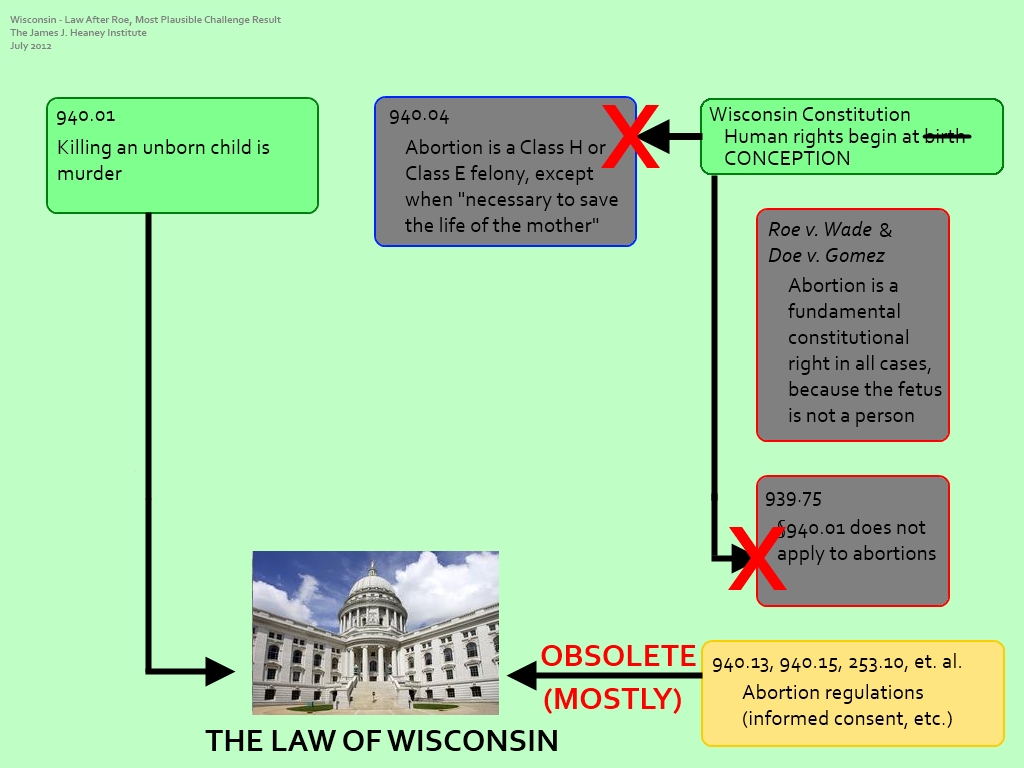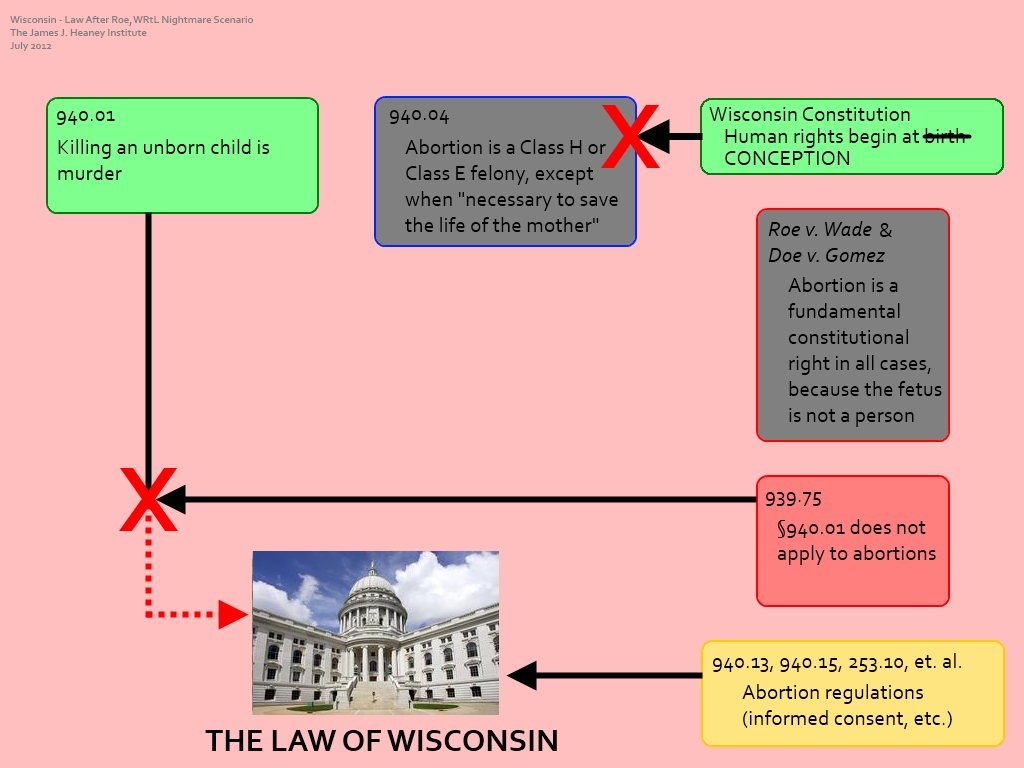This post is a direct continuation of Part III of my series on Personhood Wisconsin. I am not even stopping to breathe, much less to recap the discussion for those of you just joining us. If you want to catch up from the beginning, the series began in Part I.
We were just discussing Wisconsin Right-to-Life’s claim that enacting Personhood could lead to an essentially unlimited right to abortion in Wisconsin, even after Roe v. Wade is overturned. I have termed this the “Nightmare Scenario.” In my previous post, I showed why the mere possibility of the Nightmare Scenario is not dispositive for the Personhood Amendment and its supporters. In this post, I aim to show why the Nightmare Scenario is much less likely than Bopp et al. contend.
The key to the Nightmare Scenario is the white paper’s claim that, under Personhood, there is a real possibility that 940.04 could be completely struck down in a court challenge. This is actually true: if the lawsuit is brought, there is a non-trivial chance it will succeed. But, if 940.04 is struck down, what would happen to unborn children? Bopp et al. believe the Nightmare Scenario is the unavoidable outcome. On the contrary, the Nightmare Scenario – the return of a virtually unstoppable right to abortion – is not only avoidable, but is arguably the least likely outcome of a successful lawsuit against 940.04.
Bear in mind, going forward, that both WRtL and I have departed the plainly beaten track of precedent to venture off into speculation that is now several degrees separated from reality. We are assuming Roe v. Wade is eventually overturned, that Personhood has passed, and that Planned Parenthood and its allies have successfully gotten their challenge lawsuit all the way to the merits of the case, which is the part of a legal case where all technicalities have been resolved and the court is finally forced to rule on the substantial legal question. That question is: does the Personhood Amendment force a court to strike down the entirety of 940.04 on the grounds that it treats unborn human beings unequally? We have further assumed that the court has already made up its mind, and that the answer is “Yes.”
We will not even discuss the argument made by the Wisconsin Legislative Council: that the court would be more likely to strike down only the “therapeutic abortion” exception than the whole law. That’s another possible outcome in which Personhood would strengthen, not weaken, Wisconsin’s protections for the unborn. It is also another possible outcome that the white paper left unaddressed, despite the WLC’s unambiguous conclusion: “…it does not appear likely that a court would be likely to hold that the proposed constitutional amendment impliedly repeals the statute as a whole” [emphasis added].
We have assumed, then, that the court will reach the least likely conclusion in this unlikely case and strike down the entirety of §940.04. What would that decision mean for Wisconsin law as a whole? Must it lead to the Nightmare Scenario, as Bopp et al. contend?
Neither I nor anybody who wrote the white paper is a prophet. None of our predictions should be understood as anything more than that, especially given our capricious and politicized judiciary. Yet we can say that some outcomes are more likely than others, based on existing law, precedents, and the inclinations of today’s judiciary, so our inquiry is not without merit.
Let us first consider Wisconsin Right-to-Life’s speculation: on page 13, the white paper contends that striking down 940.04 using the Personhood Amendment would lead directly to the Nightmare Scenario, because there would be no remaining protections for the unborn in the state of Wisconsin. The Personhood Amendment, by this point, likely would have already seen a federal court challenge, with the court ruling that it has no direct force over abortions (at least not while Roe survived). In any event, the Personhood Amendment could not, in itself, provide a replacement for the lost anti-abortion statute, and, lacking legal protection, thousands of unborn children would die.
Or, as the white paper puts it (page 13):
Assume that the proposed state constitutional amendment is adopted, Roe is overruled, and §940.04 [is] declared unconstitutional under the amendment. Would the proposed state constitutional amendment sufficiently protect the unborn?
… [T]he answer is no…
Supporters of the [Personhood] proposal insist that it is not intended to… in and of itself prohibit abortion… The only way it could have that effect would be if it were interpreted as implicitly amending existing unlawful homicide statutes to bring abortion within their scope by defining “person” and “people” to include unborn children. It is extremely unlikely that the Wisconsin Supreme Court would countenance such an interpretation…
A measure that had been successfully defended against constitutional attack before Roe v. Wade was overturned on the ground that it did not criminalize abortion either directly or by implication could not credibly be used to prosecute abortionists under criminal statutes that had never before been understood as applying to abortions… Hence, it is very hard to imagine any circumstances under which a criminal prosecution under the Personhood Amendment would even be attempted, much less successful.
It is not clear to me whether Bopp et al. are deliberately giving a dumbed-down explanation of existing homicide statutes in order to communicate with a wide audience, or if they sincerely but quite wrongly believe that this is how Wisconsin homicide law works. I tremble in my mismatched dark socks to write those words of such esteemed comrades in the pro-life cause, but, unless the statute I’m reading isn’t the real Wisconsin homicide law, they’ve got it wrong – and importantly wrong.
You may already see this coming, because I’ve been quietly pounding it into your head throughout this entire post, but here, for the record, is the complete Wisconsin statute on first-degree murder [bolding mine]:
940.01 First-degree intentional homicide.
(1) Offenses.
(a) Except as provided in sub. (2), whoever causes the death of another human being with intent to kill that person or another is guilty of a Class A felony.
(b) Except as provided in sub. (2), whoever causes the death of an unborn child with intent to kill that unborn child, kill the woman who is pregnant with that unborn child or kill another is guilty of a Class A felony.
(2) Mitigating circumstances. The following are affirmative defenses to prosecution under this section which mitigate the offense to 2nd-degree intentional homicide under s. 940.05:
(a) Adequate provocation. Death was caused under the influence of adequate provocation as defined in s. 939.44.
(b) Unnecessary defensive force. Death was caused because the actor believed he or she or another was in imminent danger of death or great bodily harm and that the force used was necessary to defend the endangered person, if either belief was unreasonable.
(c) Prevention of felony. Death was caused because the actor believed that the force used was necessary in the exercise of the privilege to prevent or terminate the commission of a felony, if that belief was unreasonable.
(d) Coercion; necessity. Death was caused in the exercise of a privilege under s. 939.45 (1).
(3) Burden of proof. When the existence of an affirmative defense under sub. (2) has been placed in issue by the trial evidence, the state must prove beyond a reasonable doubt that the facts constituting the defense did not exist in order to sustain a finding of guilt under sub. (1).
There is absolutely no need for the Wisconsin Supreme Court to “countenance the interpretation” that unborn children are already presently within the scope of Wisconsin’s murder statutes. Unborn children are already, explicitly, beyond question, within that scope. There is absolutely no interpretative space for the Wisconsin Supreme Court to maneuver, no matter how strongly the justices may support abortion rights. It is one of Wisconsin law’s best features, from a pro-life defensive standpoint. “Implicit amendment,” then, is not the question Wisconsin courts will have to face if and when 940.04 is struck down – and that’s good, because, as the white paper suggests, the doctrines of implied repeal and amendment are a very chancey and uncertain basis for any legal case, especially before a court hostile to your aims. (If only Mr. Bopp had recognized that in his 2007 memo against Georgia’s Personhood initiative, as well.) Let us dispense with it.
What, then is the question the Wisconsin courts would face once the decision has been made to strike down 940.04?
Answer: “If §940.04 is unconstitutional under Personhood, isn’t §939.75(2)(b)(1) unconstitutional, too?”
Remember 939.75? It hasn’t been mentioned for a while, but it’s been in all the charts. It’s the law that prevents the murder law from applying to aborted children. Actually, though, I have oversimplified the statute a little bit up to this point. The specific provision that makes abortion an exception to the murder law is 939.75(2)(b)(1). Other provisions of 939.75 make several quite rational exceptions to the murder law. For example, 939.75(2)(b)(2) protects a doctor from a murder charge if he accidentally kills an unborn child in the course of amniocentesis, or if the baby dies accidentally during the mom’s cancer treatment, or has to be removed prematurely (but non-violently) due to an ectopic pregnancy and does not survive. 939.75(2)(b)(3) protects a mother from prosecution for murder if she suffers a miscarriage (for example, if a pregnant mom falls down the stairs and loses the baby). Basically, the other provisions of 939.75 make it clear that common accidents and tragedies of pregnancy aren’t murder. They prove that all of Planned Parenthood’s most insane claims about Personhood (“Personhood would make ectopic pregnancy a death sentence!” “Under Personhood, moms who miscarry would go to prison!”) are… well, to use an ugly word… lies.
939.75(2)(b)(1), though, is a completely different story. It does not protect people from prosecution for common accidents. It says that attacking and killing a living human being, deliberately, with malice aforethought, is not murder, simply because the victim happens to be located in his or her mother’s womb. It is discrimination of the most odious sort. If 940.04 is unconstitutional because it denies the unborn equal protection of the laws, then 939.75(2)(b)(1) is surely no less unconstitutional.
Here is the statute, in its entirety (I have bolded the bit – (2)(b)(1) – that would be hypothetically found unconstitutional):
939.75 Death or harm to an unborn child.
(1) In this section and ss. 939.24 (1), 939.25 (1), 940.01 (1) (b), 940.02 (1m), 940.05 (2g) and (2h), 940.06 (2), 940.08 (2), 940.09 (1) (c) to (e) and (1g) (c), (cm), and (d), 940.10 (2), 940.195, 940.23 (1) (b) and (2) (b), 940.24 (2) and 940.25 (1) (c) to (e), “unborn child” means any individual of the human species from fertilization until birth that is gestating inside a woman.
(2)
(a) In this subsection, “induced abortion” means the use of any instrument, medicine, drug or other substance or device in a medical procedure with the intent to terminate the pregnancy of a woman and with an intent other than to increase the probability of a live birth, to preserve the life or health of the infant after live birth or to remove a dead fetus.
(b) Sections 940.01 (1) (b), 940.02 (1m), 940.05 (2g) and (2h), 940.06 (2), 940.08 (2), 940.09 (1) (c) to (e) and (1g) (c), (cm), and (d), 940.10 (2), 940.195, 940.23 (1) (b) and (2) (b), 940.24 (2) and 940.25 (1) (c) to (e) do not apply to any of the following:
1. An act committed during an induced abortion. This subdivision does not limit the applicability of ss. 940.04, 940.13, 940.15 and 940.16 to an induced abortion.
2. An act that is committed in accordance with the usual and customary standards of medical practice during diagnostic testing or therapeutic treatment performed by, or under the supervision of, a physician licensed under ch. 448.
2h. An act by any health care provider, as defined in s. 155.01 (7), that is in accordance with a pregnant woman’s power of attorney for health care instrument under ch. 155 or in accordance with a decision of a health care agent who is acting under a pregnant woman’s power of attorney for health care instrument under ch. 155.
3. An act by a woman who is pregnant with an unborn child that results in the death of or great bodily harm, substantial bodily harm or bodily harm to that unborn child.
4. The prescription, dispensation or administration by any person lawfully authorized to do so and the use by a woman of any medicine, drug or device that is used as a method of birth control or is intended to prevent pregnancy.
(3) When the existence of an exception under sub. (2) has been placed in issue by the trial evidence, the state must prove beyond a reasonable doubt that the facts constituting the exception do not exist in order to sustain a finding of guilt under s. 940.01 (1) (b), 940.02 (1m), 940.05 (2g), 940.06 (2), 940.08 (2), 940.09 (1) (c) to (e) or (1g) (c), (cm), or (d), 940.10 (2), 940.195, 940.23 (1) (b) or (2) (b), 940.24 (2) or 940.25 (1) (c) to (e).
According to the white paper, the reason 940.04 could be struck down is because a “dramatic difference in treatment between intentionally killing people before and after birth simply cannot be squared with the amendment’s prescription of equality.” 940.04 merely makes abortion a lesser felony than a murder, and our hypothetical court has held even that relatively minor difference unconstitutional. However, if 940.04 is struck down, as our scenario presumes, 939.75(2)(b)(1) becomes the law that causes murder of a born person to be treated as murder… but murder of an unborn person to be treated as no crime at all! This raises extremely strong equal protection concerns – concerns which the court will have already admitted with respect to 940.04. If the same reasoning applies – and it seems more likely than unlikely that it would – 939.75(2)(b)(1) would have to be struck down, as well. The result would suddenly turn the Nightmare Scenario into near-total victory for Pro-Lifers: abortion would become murder under the law of Wisconsin. Which brings us to our final chart, the more plausible ALTERNATIVE SCENARIO to the Nightmare Scenario:
I discuss the case for the Alternative Scenario at greater length in the Appendix.
Bopp et al. spend only one sentence in their entire white paper contemplating what would happen if 939.75(2)(b)(1) were struck down, bringing abortion back within the scope of Wisconsin’s murder laws on an equal protection analysis. They write the following, without providing any discussion or evidence (page 4):
If the amendment were held to make existing intentional homicide statutes applicable to abortion, women who have abortions would be subject to mandatory life sentences.
Wisconsin Right-to-Life seems to consider this a bad outcome. (When I asked them directly about their ideal Wisconsin abortion law, the only answer I received was the white paper.) Most pro-lifers I know would agree: the consensus throughout the movement is that mothers should not be prosecuted for killing their children in an abortion. On the other hand, I know a few pro-lifers who believe murder is murder, and that it would be good for aborting moms to face life sentences. For myself – if I may digress into purely personal opinion for a moment – I am very uncomfortable, like most of society, with the idea of putting a woman in prison for maliciously murdering her unborn child. On the other hand, unlike most of society, I am very uncomfortable with the idea of putting a woman in prison for maliciously murdering her one-year-old child. I am not certain how mothers in those two circumstances should be treated by the law, but I am certain that the treatment should be the same. Take that however you will. (The usually-wrong but always-genuine William Saletan has a good discussion of the question here.)
However, my personal opinion on the matter has little to do with the legal reality, and the reality of the Alternative Scenario is that Bopp et al. do not prove their case. Heck, they don’t even try. They provide absolutely no evidence in support of their contention. This is a serious problem, because – well, just look back at the chart above. Notice §940.13? It’s in the yellow box in the lower right. In both the Nightmare Scenario and the Alternative Scenario §940.13 is still on the books. Do you remember what §940.13 is?
It’s the “maternal exception clause”:
940.13 Abortion exception. No fine or imprisonment may be imposed or enforced against and no prosecution may be brought against a woman who obtains an abortion or otherwise violates any provision of any abortion statute with respect to her unborn child or fetus, and s. 939.05 [aiding and abetting], 939.30 [solicitation] or 939.31 [conspiracy] does not apply to a woman who obtains an abortion or otherwise violates any provision of any abortion statute with respect to her unborn child or fetus.
In the Alternative Scenario, the maternal exception clause is still on the books.
It is difficult to imagine either abortion’s allies or its opponents challenging 940.13 in court, or introducing it as a question into a larger abortion case. Pro-lifers, as I mentioned, don’t want to put mothers in jail, and Planned Parenthood only wants to deprive women of their rights if they’re still in the womb. Moreover, it is not entirely clear how any party would gain legal standing to make the challenge.
To be sure, if somebody did decide, for some reason, to challenge 940.13 under the Alternative Scenario, the defense would face a stiff challenge on the same equal protection claims that will have already felled 940.04 and 939.75(2)(b)(1). Even so, this exception might plausibly be saved (albeit perhaps in more limited form) by presenting a rational basis for keeping the exception. Generally speaking, a court cannot strike down a law as unconstitutional unless it is “without any reasonable basis and therefore is purely arbitrary” (Lindsley v. Natural Carbonic Gas Co. (1991)). This is called the “rational basis” standard. In order to be held constitutional under the rational basis standard in Wisconsin, a law must pass a five-point test (Omernik v State (1974)):
(1) All classification must be based upon substantial distinctions;
(2) the classification must be germane to the purpose of the law;
(3) the classification must not be based on existing circumstances only;
(4) the law must apply equally to each member of the class; and
(5) the characteristics of each class should be so far different from those of other classes as to reasonably suggest the propriety of substantially different legislation.
“The basic test is not whether some inequality results from the classification,” the Court goes on, “but whether there exists any reasonable basis to justify the classification.” It later synthesized and applied a simple expression of the same rule: “…legislation is presumed to be valid and will be sustained if the classification drawn by the statute is rationally related to a legitimate state interest” (Funk v. Wollin Silo & Equipment, Inc. (1989)). This is identical to the Supreme Court’s criterion for rational basis review: “…this Court requires, at a minimum, that a statutory classification bear some rational relationship to a legitimate state purpose” (Weber v. Aetna (1972)).
Unlike the induced abortion exception in 939.75(2)(b)(1), whose sole purpose was to provide for the deprivation of human rights by the strong against the weak, the maternal exception clause in 940.13 does bear “some rational relationship to a legitimate state purpose.” It can be held constitutional under the rational basis standard. What “legitimate state purpose”, you ask?
Many pro-lifers argue that mothers should not be prosecuted for the same reason that law enforcement focuses on drug dealers and copyright pirates rather than drug users and illegal downloaders: even though these mothers committed a serious crime, they are typically accomplices, not the primary criminal actors, and their cooperation is vital in bringing much worse bad guys – the cold-blooded, for-profit abortionists – to justice. Alternatively, as other pro-lifers argue, mothers who get abortions frequently operate under a certain amount of duress (from families or significant others), and their culpability is reduced accordingly.
If the state legislature has found, on its own examination of the issues, that an absolute maternal exception is more advantageous to Wisconsin’s abortion enforcement efforts than putting aborted mothers in danger of prison, or that abortive mothers, broadly speaking, cannot be held responsible for getting abortions, then that exception would bear a “rational relationship” to the “legitimate state purpose” of minimizing the murders of unborn children and maximizing the criminal convictions of the most serious malefactors while conserving justice in those cases. The courts would have little room to declare 940.13 unconstitutional. Importantly, the courts cannot closely review the legislature’s practical real-world findings. Under pure rational basis analysis, even if the rational basis presented is merely a pretext for the genuine motive for a piece for legislation, the Court presumes the best of the legislature and upholds it anyway (U.S. v. Carolene Products (1938), Williamson v. Lee Optical (1955)) – although this standard has been somewhat eroded in recent years (Kelo v. New London (2005), Romer v. Evans (1996)), and is not as strong under Wisconsin’s Omernik Test (see Omernik rule #5 above).
So we see that, even if the unlikely comes to pass and the Alternative or Nightmare scenario actually happens, and even if 940.13 is, for some reason, challenged in court (which seems even more unlikely), there is at least a plausible possibility that women will not face prosecution for murder under Personhood. (However, there is also a real chance that the challenge to 940.13 would trigger strict scrutiny review, and it is much less likely to survive that level of review. More discussion of strict scrutiny in the appendix.)
Now let’s consider one more thing: this discussion of murder exceptions and maternal immunity is all based on our assumption that Planned Parenthood and its allies attempted, in the first place, to bring about the Nightmare Scenario by challenging section 940.04. We’ve spent the last ten pages in a sort of speculative alternative universe where that happened, and, to one extent or another, Planned Parenthood succeeded (in the Alternative Scenario, it succeeded so well that the case backfired on them, by killing 939.75(2)(b)(1) as well). The white paper and I agree that Planned Parenthood is unlikely to succeed in bringing about the Nightmare Scenario. I have just presented a seemingly more plausible Alternative Scenario where, rather than bringing back abortion rights from the brink of Roe, Planned Parenthood accidentally triggers a constitutional prohibition on abortion, and even made Wisconsin’s moms less invulnerable to abortion laws – all because it decided to fight Personhood rather than go along with it. As I mentioned earlier, the Wisconsin Legislative Council, which does not have a dog in this fight, found a completely different way a court case against Personhood could trigger the same doomsday for the abortion industry. Given the cost/benefit analysis, how likely is it that Planned Parenthood and its allies would even undertake this risky lawsuit, jeopardizing all that would remain of their abortion businesses, in the first place? It could only be an act of extreme desperation, and it would betray their own professed loyalty to women in favor of their business model (which is still 20% abortions).
From all of the foregoing, we may reasonably conclude that, if Personhood is passed, the most likely outcome is Personhood Wisconsin’s Vision:
Abortion is mostly illegal, punishable as a minor felony, with an exception for the life of the mother left in place. Mothers are immune to prosecution under abortion statutes, which means the punishment falls entirely on the heads of abortionists themselves. Most pro-lifers would call this a mostly-victory.
If the lawsuit against 940.04 is nevertheless attempted and, to everyone’s surprise, succeeds, the next-most plausible outcome would be some version of the Alternative Scenario:
Abortion is a Class A felony, equivalent to murder. While, thanks to the protections provided by 939.75(2)(b)(2)), it still remains entirely possible to adequately treat a mother in a dangerous pregnancy — even if the treatment unfortunately leads to the death of her unborn child — doctors are forced to practice a humane form of medicine that treats both mother and child as patients, rather than treating the child as a tumor. This scenario is also a victory, although more thought clearly needs to be given to the nature and extent of the maternal exception law.
The least likely outcome of passing Personhood, I contend, is what Wisconsin Right-to-Life proposes as its Nightmare Scenario:
940.04 is struck down in its entirety, but 939.75 is not, re-establishing a nearly-unlimited right to an abortion even after Roe is gone. This is a horrifying, if remote, possibility.
On the other hand, inaction is not without risks, either, as we found when we examined Wisconsin law post-Roe v Wade if the state doesn’t pass Personhood or something like it:
Existing anti-abortion law is very, very vulnerable to an unamended Wisconsin Constitution, and that’s a risk we need to consider when deciding whether or not to support Personhood or not.
Of course, almost anything would be better than current law:
All legislative actions, especially legislative actions on abortion, are a balance of likely risks versus likely rewards. Every Wisconsin pro-lifer – and, one day, I hope, every Wisconsin voter – will have to draw his or her own conclusion about the risks and rewards of the Personhood Amendment. For my money, however, the Personhood Amendment is an effective way to defend Wisconsin’s unborn children from a rogue clause of the Wisconsin Constitution while affirming that Wisconsin has a culture of life. It carries likely and significant benefits after Roe v. Wade is overturned, and very unlikely or relatively insignificant risks.
Wisconsin Right-to-Life and Bopp et al. remain friends and allies within the pro-life movement, but they have gravely misrepresented the Personhood cause to the voters they purport to serve – no doubt without intending to do so. They ought to immediately revise, retract, or expand upon all their statements on Personhood, especially the enormously deceptive claims made on their website and in their printed brochures. This is all I can insist upon as a matter of demonstrated fact.
However, where I cannot prescribe in foro indicii, I shall entreat in foro conscientiae, on no authority other than the bonds of affection that conjoin all of us who stand united in the cause to abolish abortion. I urge Mrs. Lyons, Mr. Bopp, and all those associated with Wisconsin Right-to-Life and the white paper to reconsider their respective positions on Personhood Wisconsin in light of the arguments I have collected here. I have spent two months toiling on these posts not to damn Wisconsin Right-to-Life, but to persuade it. Even upon deeper reflection, perhaps these pro-life friends will find themselves unable to support the Wisconsin Personhood Amendment, for reasons, prudential or substantive, which I may not be able to fathom. But I beg that the reflection be made, in the silence of the spirit and the quiet of the law library, without peremptory intervention by the prejudice of faction or the fear for political embarrassment, so that the course of action most beneficial to Wisconsin’s unborn children may be discerned and pursued.
As I stated way back in my first post, I am not a lawyer, and I have only a keen amateur interest in the law. I am genuinely baffled by what I have seen in Wisconsin Right-to-Life’s papers. The possibility that I am wrong and a slew of pro-life luminaries like Jim Bopp are right is hardly negligible. I invite responses and constructive criticism (or heck, destructive criticism, too) from you, the readers. Further, as I promised at the outset, I will reprint, in full, any response I may receive from Wisconsin Right-to-Life or any of the signatories of their white paper, even if I do not find their case persuasive.
Thank you, dear reader, for your time and patience, and I hope you and your elected officials will make the right choice for Wisconsin’s unborn children – whatever that choice proves to be.
N.B.: I am including a further appendix discussing the constitutionality of 939.75(2)(b)(1) at greater length. That is also where I include my discussion of strict scrutiny, which I promised above.






